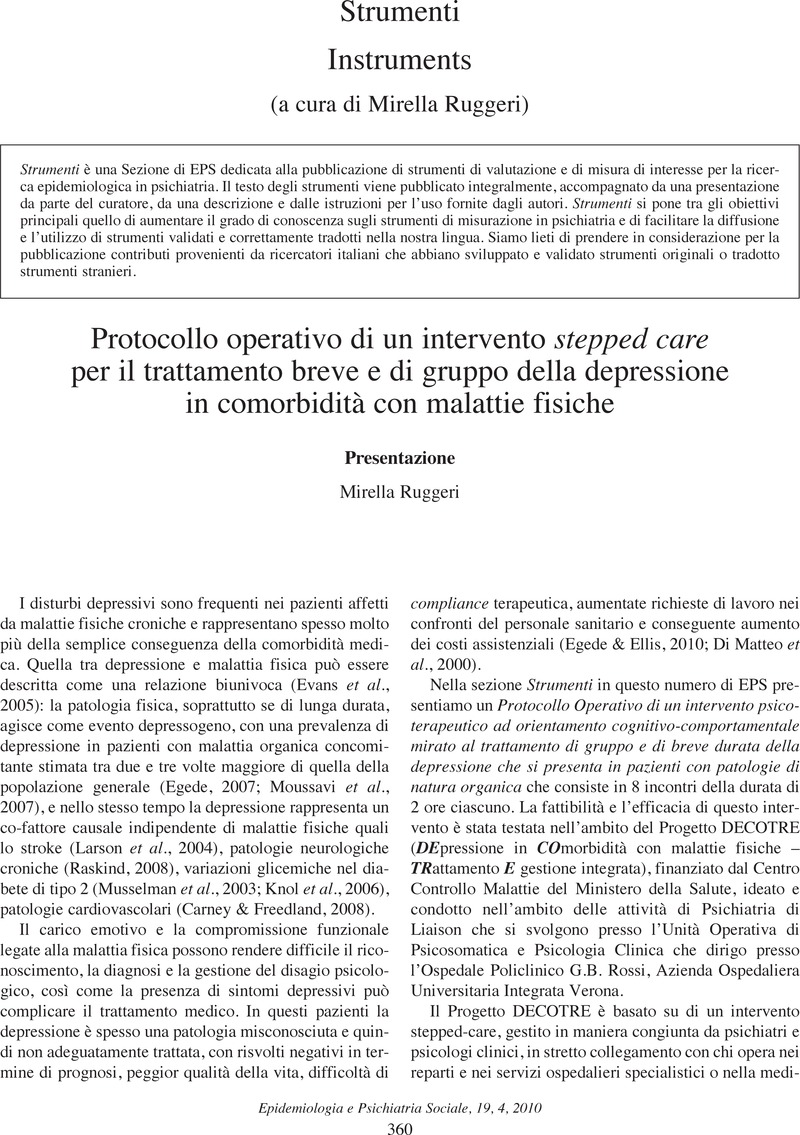No CrossRef data available.
Article contents
Protocollo operativo di un intervento stepped care per il trattamento breve e di gruppo della depressione in comorbidità con malattie fisiche, Presentazione
Published online by Cambridge University Press: 11 April 2011
Abstract
An abstract is not available for this content so a preview has been provided. Please use the Get access link above for information on how to access this content.

- Type
- Strumenti/Instruments
- Information
- Copyright
- Copyright © Cambridge University Press 2010
References
BIBLIOGRAFIA
Beck, A.T., Rusch, A.J., Shaw, B.F. & Emery, G. (1979). Cognitive Therapy of Depression. Guilford Press: New York.Google Scholar
Carney, R. & Freedland, K. (2008). Depression in patient with coronary heart disease. American Journal of Medicine 121, s20-–s27.Google Scholar
Di Matteo, M.R., Lepper, H.S & Croghan, T.W. (2000). Depression is a risk factor for non-compliance with medical treatment: meta—analy sis of the effects of anxiety and depression on patient adherence. Annals of Internal Medicine 160, 2101–2107.Google Scholar
Egede, L. (2007). Major depression in individuals with chronic medical disorders: prevalence, correlates and association with health re source utilization, lost productivity and functional disability. General Hospital Psychiatry 29, 409–416.Google Scholar
Egede, L. & Ellis, C. (2010). Diabetes and depression: global perspectives. Diabetes Research and Clinical Practice 87, 302–312.Google Scholar
Evans, D.L., Charney, D.S., Lewis, L., Golden, R.N., Gorman, J.M., Krishnan, K.R., Nemeroff, C.B., Bremner, J.D., Carney, R.M., Coyne, J.C., Delong, M.R., Frasure-Smitrh, N., Glassmna, A.H., Gold, P.W., Grant, I., Gwyther, L., Ironson, G., Johnson, R.L., Kanner, A.M., Katon, W.J., Kaufmann, P.G., Keefe, F.J., Laughren, T.P., Leserman, J., Lyketsos, C.G., McDonald, W.M., McEwen, B.S., Miller, A.H., Musselman, D., O'Connor, C., Petitto, J.M., Pollock, B.G., Robionson, R.G., Roose, S.P., Rowland, J., Sheline, Y., Sheps, D.S., Simon, G., Spiegel, D., Stunkard, A., Sunderland, T., Tibbits, P. & Valvo, W.J. (2005). Mood disorders in the medically ill: scientific review and recommendations. Biological Psychiatry 58, 175–189.CrossRefGoogle Scholar
Knol, M.J., Twisk, J.W.R., Beekman, A.T.F., Heine, R.J., Snoek, F.J. & Pouwer, F. (2006). Depression as a risk factor for the onset of type 2 diabetes mellitus. A meta-analysis. Diabetologia 49, 837–845.Google Scholar
Larsson, K., Thorslund, M. & Forsell, Y. (2004). Dementia and depressive symptoms as predictors of home help utilization among the oldest old: population-based study in an urban area of Sweden. Journal of Aging Health 16, 641–668.Google Scholar
Moussavi, S., Chatterji, S., Verdes, E., Tandon, A., Patel, V. & Ustun, B. (2007). Depression, chronic diseases and decrements in health: results from the World Health Surveys. Lancet 370, 851–858.Google Scholar
Musselman, D.L., Betan, E., Larsen, H. & Phillips, L.S. (2003). Relationship of depression to diabetes types 1 and 2: epidemiology, biology and treatment. Biological Psychiatry 54, 317–329.CrossRefGoogle ScholarPubMed
Raskind, M.A. (2008). Diagnosis and treatment of depression comorbid with neurologic disorders. American Journal of Medicine 121, s28–s37.CrossRefGoogle ScholarPubMed
Van der Ven, N.C., Lubach, C.H., Hogenelst, M.H., van Iperen, A., Tromp-Wever, A.M., Vriend, A., van der Ploeg, H.M., Heine, R.J. & Snoek, F.J. (2005). Cognitive behavioural group training (CBGT) for patients with type 1 diabetes in persistent poor glycaemic control: who do we reach? Patient Education and Counseling 56, 313–22.Google Scholar


